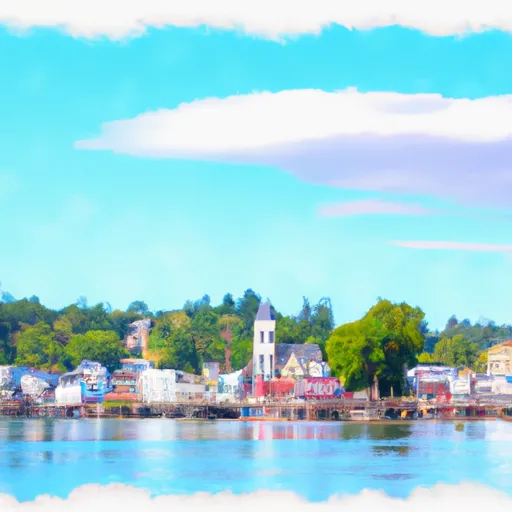-
 Snoflo Premium
Snoflo Premium
Get unlimited access to all our content
With no Ad interruptions! - Start Your Free Trial Login with existing account
Port-Gamble
Eden Index
Climate
8.3
•
Recreation
3.7
•
Community
1.3
•
Safeguard
4.9/10

Port Gamble is a charming town located on the Kitsap Peninsula in Washington State. Known for its historical significance and natural beauty, Port Gamble offers a unique experience for visitors and residents alike.
In terms of climate, Port Gamble enjoys a mild marine climate, characterized by cool winters and warm summers. The town receives abundant rainfall throughout the year, contributing to the lush greenery and vibrant flora.
The hydrology constituents in Port Gamble are primarily influenced by the nearby Hood Canal and Puget Sound. These bodies of water provide a plethora of recreational opportunities, including boating, fishing, and kayaking. Exploring the picturesque shorelines and observing wildlife are popular activities for outdoor enthusiasts in this area.
For those seeking outdoor adventures, Port Gamble offers numerous opportunities. The town is surrounded by enchanting forests and has several nearby parks, such as Port Gamble Forest Heritage Park and Kitsap Memorial State Park, ideal for hiking, camping, and wildlife spotting. The area also boasts scenic biking trails and is a gateway to Olympic National Park, which offers vast wilderness and stunning vistas.
What is the Eden Index?
The Snoflo Eden Index serves as a comprehensive rating system for regions, evaluating their desirability through a holistic assessment of climate health, outdoor recreation opportunities, and natural disaster risk, acknowledging the profound impact of these factors on livability and well-being.
Climate Health Indicator (CHI): 8.3
Port-Gamble receives approximately
878mm of rain per year,
with humidity levels near 82%
and air temperatures averaging around
11°C.
Port-Gamble has a plant hardyness factor of
8, meaning
plants and agriculture in this region tend to thrive here all year round.
By considering the ideal temperature range, reliable water supplies, clean air, and stable seasonal rain or snowpacks, the Climate Health Indicator (CHI) underscores the significance of a healthy climate as the foundation for quality living.
A healthy climate is paramount for ensuring a high quality of life and livability in a region, fostering both physical well-being and environmental harmony. This can be characterized by ideal temperatures, reliable access to water supplies, clean air, and consistent seasonal rain or snowpacks.
Weather Forecast
Streamflow Conditions
Puget Sound
Area Rivers
Puget Sound
Snowpack Depths
Puget Sound
Reservoir Storage Capacity
Puget Sound
Groundwater Levels
Recreational Opportunity Index (ROI): 3.7
The Recreational Opportunity Index (ROI) recognizes the value of outdoor recreational options, such as parks, hiking trails, camping sites, and fishing spots, while acknowledging that climate plays a pivotal role in ensuring the comfort and consistency of these experiences.
Access to outdoor recreational opportunities, encompassing activities such as parks, hiking, camping, and fishing, is crucial for overall well-being, and the climate plays a pivotal role in enabling and enhancing these experiences, ensuring that individuals can engage in nature-based activities comfortably and consistently.
Camping Areas
| Campground | Campsites | Reservations | Toilets | Showers | Elevation |
|---|---|---|---|---|---|
| Manchester State Park | 35 | 27 ft | |||
| Fort Casey State Park | 35 | 11 ft | |||
| Fay Bainbridge State Park | 65 | 15 ft | |||
| Illahee State Park | 23 | 254 ft | |||
| Camano Island State Park | 88 | 181 ft | |||
| Fort Flagler State Park | None | 100 ft | |||
| Fort Worden State Park | 80 | 173 ft | |||
| Jefferson County Fairgrounds | 80 | 17 ft | |||
| Fort Townsend State Park | 40 | 247 ft | |||
| Kitsap Memorial State Park | 40 | 46 ft |
Nearby Ski Areas
Catastrophe Safeguard Index (CSI):
The Catastrophe Safeguard Index (CSI) recognizes that natural disaster risk, encompassing floods, fires, hurricanes, and tornadoes, can drastically affect safety and the overall appeal of an area.
The level of natural disaster risk in a region significantly affects safety and the overall livability, with climate change amplifying these risks by potentially increasing the frequency and intensity of events like floods, fires, hurricanes, and tornadoes, thereby posing substantial challenges to community resilience and well-being.
Community Resilience Indicator (CRI): 1.3
The Community Resilience Indicator (CRI) recognizes that education, healthcare, and socioeconomics are crucial to the well-being of a region. The CRI acknowledges the profound impact of these elements on residents' overall quality of life. By evaluating educational resources, healthcare accessibility, and economic inclusivity, the index captures the essential aspects that contribute to a thriving community, fostering resident satisfaction, equity, and social cohesion.

